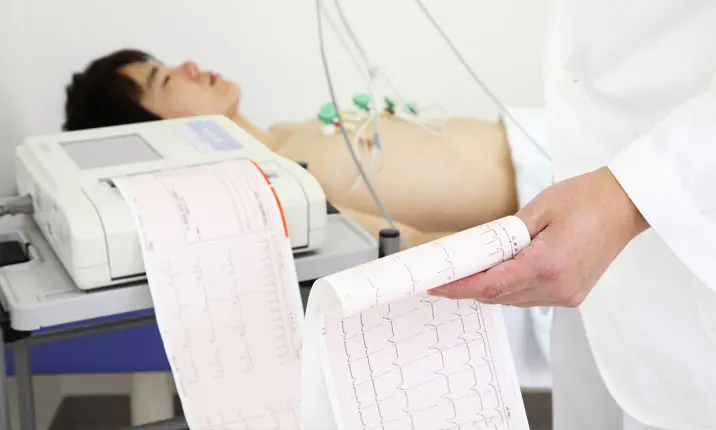Are you planning to run a marathon? Even if you're not, understanding your heart rate is essential as it can tell you more about your fitness level and even highlight potential health problems. After all, heart health is central to whole-body wellness.
Continue reading to find out more about your heart rate, and when you should see a doctor if something does not appear right.
How the heart works
You probably already know this, but your heart is a finely tuned muscular double pump that sends blood around the body, delivering vital oxygen and nutrients to every tissue.
And a healthy heart does this with a steady rate or rhythm that we don't always notice or keep track of.
What is a normal heart rate?
Each of the two-part pumping phases that happen in the heart counts as 1 heartbeat. And the number of heartbeats in one minute is referred to as our heart rate (HR).
For healthy adults at rest, their HR typically ranges from 60 – 100 beats per minute (BPM). However, there is a wide range of what's considered normal, and it varies between individuals. For example, a fit athlete may have a resting HR of just 40 – 60 BPM.
Children have a wide HR range as well. A newborn baby could have a HR that is as high as 190 BPM, and slows down gradually as their bodies (and their hearts) develop. As children grow, their HR will eventually match that of an adult's, typically by about 10 years of age.
Factors that influence heart rate
It's important to note there are many different causes for increased or decreased HR. These include:
- Age
- Emotions
- Fitness level
- Health conditions like cardiovascular disease, high cholesterol, or diabetes
- Medication
- Smoking and alcohol consumption
- Weight
Also, body position while taking heart rate measurements can affect the results. For example, lying down and being relaxed helps lower one's blood pressure and HR.
Finding your heart rate
Each heartbeat pushes blood through the circulatory system, creating a 'pulse' of blood, the indicator of HR. Most fitness trackers are worn on the wrist, measuring the body's heart rate at that common point.
To manually measure your heart rate, place a finger, not thumb, over the pulse and count the number of beats in 15 seconds and multiply by 4.
What is heart rate training, and why use it?
So how can HR help with fitness?
HR training uses your HR as either BPM or as a percentage of your maximum heart rate (MHR). Your MHR is 220 minus your age.
This can be used to guide a fitness routine and create specific training 'zones'. This will allow one to maximise every workout, while avoiding overtraining because it tells you just how hard the body has been made to work during each session. It's easier to get the results you want and track the progress towards your fitness goals.
What are the different heart rate zones?
There are 5 different heart rate zones and they relate to exercise intensity:
| Zone 1 Very light effort 50 – 60 % of MHR |
Burns: 85% fat 5% protein 10% carbohydrates |
| Zone 2 Light effort 60 – 70% of MHR |
Burns: 85% fat 5% protein 10% carbohydrates |
| Zone 3 (Aerobic Zone) Moderate effort 70 – 80% of MHR |
Burns: 50% fat >1% protein 50% carbohydrates |
| Zone 4 (Anaerobic Zone) Hard effort 80 – 90% of MHR |
Burns: 15% fat >1% protein 85% carbohydrates |
| Zone 5 (Red-line Zone) Very hard effort 90 – 100% of MHR |
Burns: 10% fat >1% protein 90% carbohydrates |
You'll get different benefits by exercising in different HR zones, as each one burns different proportions of carbohydrates, protein, and fat.
Ideally for the best results, fitness routines should be varied for length and intensity, with recovery days in between. The best workout routine for you depends on your specific goals. This could be weight loss, or training towards completing an endurance event.
It's easiest to monitor your HR with a fitness monitor, but you can calculate the rates by taking your pulse regularly as you exercise.
Factors that influence heart rate during exercise
The same factors that typically affect HR also apply during exercise. You should also consider the following factors when working out as they may influence your reading and performance.
- Body temperature: If you're too hot or cold, your HR typically increases as your body works to keep warm, or cool down, especially in high humidity or extreme cold.
- Terrain: HR increases as your body works harder when you move uphill or negotiate difficult terrain.
- Wind: Running into the wind is more difficult and increases HR.
- Dehydration: If you don't replace the water you're using up, your HR increases as your heart works harder when dehydrated.
- Reduced glycogen stores: As your bodies fuel levels drop, your HR rises.
When to worry about heart rate during exercise
Stop any exercise of physical activity if you feel your HR becoming uncomfortable, especially if you begin to feel weak, dizzy, short of breath, or faint. Seek medical attention promptly at the nearest Urgent Care Centre (UCC). If the symptoms resolve, do schedule an appointment with your primary physician to discuss further.
Signs there could be heart issues
With regular exercise, you will begin to know what feels normal or comfortable. You will also be more familiar with your HR readings with the efforts you put into your workout. Should your HR vary too much from what's normal for you, it could be a sign of an underlying problem.
A slow HR could indicate an underactive thyroid, or point to an intrinsic electrical problem that prevents the electrical impulses responsible for coordinating your heartbeat from working properly. A faster than typical HR could be caused by infections and fever, anaemia and asthma.
What to do if you are worried about heart disease
Because heart health is paramount, one should, at the first sign of any symptoms or abnormal pulse, make an appointment to see your doctor. He or she will be able to advise you on the next steps, and may want to examine you for heart health issues.
How to screen for heart health issues
If your doctor suspects a possible heart issue, you may be screened to rule out specific problems, and begin any treatment as early as possible.
These are some of the tests that may feature in a heart screening:
- Electrocardiography (ECG): Measures the heart's electrical activity, HR, and rhythm.
- Treadmill stress test: Involves measuring the heart's rate, rhythm, electrical activity, and blood pressure while the patient walks on a treadmill at increasing difficulty levels of difficulty.
- Echocardiography: This ultrasound takes moving pictures of the heart, either at rest or following exercise.
- Holter monitor: Heart rhythm monitoring which allows continuous surveillance of the heart's rhythm over 24 – 72 hours.
HR is an excellent indicator of overall health. It can also help you to optimise your fitness routine and monitor your progress.
However, it may be advisable to consult your doctor if you have prior heart health issues for advice before beginning any exercise programme to make sure that it won't pose a medical risk. Should any chest pain, breathing difficulties, dizziness, or fainting, be experienced at any point before, during or after a workout, notify your doctor as a matter of urgency. Make staying healthy and keeping well your priority.















